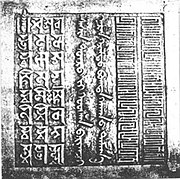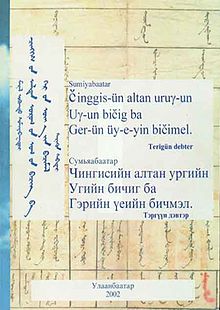
The Golden Horde, self-designated as Ulug Ulus, was originally a Mongol and later Turkicized khanate established in the 13th century and originating as the northwestern sector of the Mongol Empire. With the division of the Mongol Empire after 1259, it became a functionally separate khanate. It is also known as the Kipchak Khanate or as the Ulus of Jochi, and it replaced the earlier, less organized Cuman–Kipchak confederation.
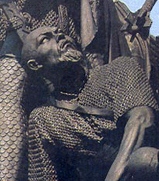
Mamai was a powerful Mongol military commander of the Golden Horde. Contrary to popular misconception, he was not a khan (king), but was a kingmaker for several khans, and dominated parts or all of the Golden Horde for a period of almost two decades in the 1360s and 1370s. Although he was unable to stabilize central authority during the war of succession known as the Great Troubles, Mamai remained a remarkable and persistent leader for decades, while others came and went in rapid succession. His defeat in the Battle of Kulikovo marked the beginning of the decline of the Horde, as well as his own rapid downfall.

The Chagatai Khanate, or Chagatai Ulus was a Mongol and later Turkicized khanate that comprised the lands ruled by Chagatai Khan, second son of Genghis Khan, and his descendants and successors. At its height in the late 13th century the khanate extended from the Amu Darya south of the Aral Sea to the Altai Mountains in the border of modern-day Mongolia and China, roughly corresponding to the area once ruled by the Qara Khitai.
The names of people, battles, and places need to be spelled as they are on other articles title and then wikified.

Kaidu was a grandson of the Mongol khagan Ögedei (1185–1241) and thus leader of the House of Ögedei and the de facto khan of the Chagatai Khanate, a division of the Mongol Empire. He ruled parts of modern-day Xinjiang and Central Asia during the 13th century, and actively opposed his uncle, Kublai, who established the Yuan dynasty. Medieval chroniclers often mistranslated Kadan as Kaidu, mistakenly placing Kaidu at the Battle of Legnica. Kadan was the brother of Güyük, and Kaidu's uncle.

The Sarbadars were a mixture of religious dervishes and secular rulers that came to rule over part of western Khurasan in the midst of the disintegration of the Mongol Ilkhanate in the mid-14th century. Centered in their capital of Sabzavar, they continued their reign until Khwaja 'Ali-yi Mu'ayyad submitted to Timur in 1381, and were one of the few groups that managed to mostly avoid Timur's famous brutality.
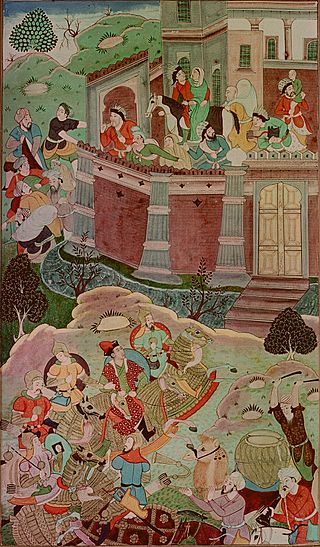
Alghu was a khan of the Chagatai Khanate (1260–1265/6). He was the son of Baidar and the grandson of Chagatai Khan.
Hajji Beg Barlas was a leader of the Barlas tribe, he was the immediate predecessor in this role to his nephew Timur, who later founded the Timurid Empire, he was the great-great-grandson Qarachar Barlas his lineages tracing as Hajji Beg the son of Burlaki Barlas the son of Nemule Barlas the son of Yesunte Mongke Barlas the son of Darughachi Qarachar Barlas, Hajji Barlas was the Mongol Military Commander, he was given Hajji title of his surname because he pilgrimages to Mecca his real name "Saif al-din Barlas", and get the Beg title was given for his Chieftain or Head-Leader of Barlas Clan.

Munkh Tumur or Möngke TemürUzbek was a son of Toqoqan Khan and Köchu Khatun of Oirat, daughter of Toralchi Küregen and granddaughter of Qutuqa Beki, and the grandson of Batu Khan. He was a khan of the Golden Horde, a division of the Mongol Empire in 1266–1280.
The family tree of Genghis Khan is listed below. This family tree only lists prominent members of the Borjigin family and does not reach the present. Genghis Khan appears in the middle of the tree, and Kublai Khan appears at the bottom of the tree. The Borjigin family was the imperial house of the Mongol Empire, dating back to the 13th and 14th centuries.
Buyan Suldus was chief of one segment of the Suldus clan of Taichuud tribe during the 1350s and 1360s, and was chief amir of the Chagatai ulus for a short time after 1358.
Timur, Temur, Temür, Temir, Teymur or Tömör is a masculine Turkic and Mongolic given name which literally means iron. It is a cognate of the Bosnian and Turkish name Demir. In Indonesian, timur translates to east, and symbolizes hope by the rising sun.
The division of the Mongol Empire began after Möngke Khan died in 1259 in the siege of Diaoyu Castle with no declared successor, precipitating infighting between members of the Tolui family line for the title of khagan that escalated into the Toluid Civil War. This civil war, along with the Berke–Hulagu war and the subsequent Kaidu–Kublai war, greatly weakened the authority of the great khan over the entirety of the Mongol Empire, and the empire fractured into four khanates: the Golden Horde in Eastern Europe, the Chagatai Khanate in Central Asia, the Ilkhanate in Southwest Asia, and the Yuan dynasty in East Asia based in modern-day Beijing – although the Yuan emperors held the nominal title of khagan of the empire.

The Kaidu–Kublai war was a war between Kaidu and Kublai from 1268 to 1301. Kaidu was the leader of the House of Ögedei and the de facto khan of the Chagatai Khanate, while Kublai was the founder of the Yuan dynasty. The Kaidu–Kublai war followed the Toluid Civil War (1260–1264) and resulted in the permanent division of the Mongol Empire. By the time of Kublai's death in 1294, the Mongol Empire had fractured into four separate polities: the Golden Horde khanate in the northwest, the Chagatai Khanate in the middle, the Ilkhanate in the southwest, and the Yuan dynasty in the east based in modern-day Beijing. Although Temür later made peace with the three western khanates in 1304 after Kaidu's death, the four successor states of the Mongol Empire continued their own separate development and fell at different times.
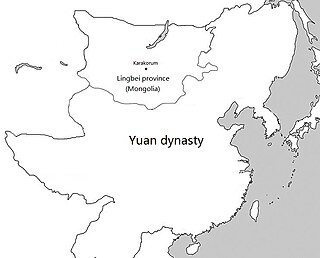
The Yuan dynasty ruled over the Mongolian Plateau, including both Inner and Outer Mongolia as well as part of southern Siberia, between 1271 and 1368. The Mongolian Plateau is where the ruling Mongol Borjigin clan of the Yuan dynasty came from, thus it enjoyed a somewhat special status during the Yuan dynasty, although the capital of the dynasty had been moved from Karakorum to Khanbaliq since the beginning of Kublai Khan's reign, and Mongolia had been converted into a regular province, known as the Lingbei Province, by the early 14th century.

ʿArab Shāh was khan of the Golden Horde in 1377–1380. He held the traditional capital Sarai during a period of civil war among rival contenders for the throne. Throughout his reign, the westernmost portion of the Golden Hode was under the control of the beglerbeg Mamai and his puppet khans, while the easternmost portion was under the control of the sons of Urus Khan and then Tokhtamysh.

The Great Troubles, also known as the Golden Horde Dynastic War, was a war of succession in the Golden Horde from 1359 to 1381.



